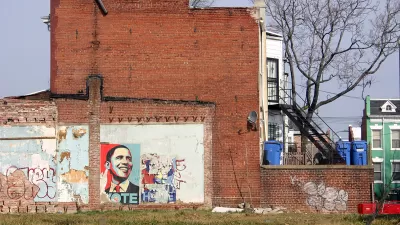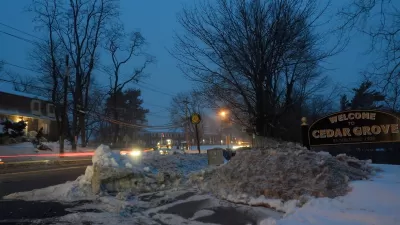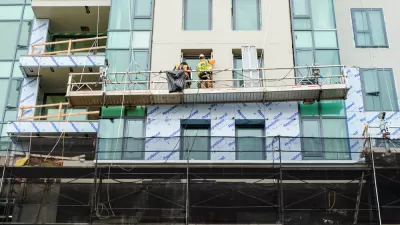As public art proliferates as a strategy to engage disaffected youth and enliven neighborhoods, Philip Langdon argues that an additional standard must be considered when evaluating such projects -- their content.
Langdon's commentary was spurred by recent discussions held at an urban journalists' forum organized by the Lincoln Institute of Land Policy, and more specifically by images of public murals shown by Roger Cummings, co-founder and artistic director of Juxtaposition Arts, an arts-oriented community development corporation in Minneapolis. Some of the murals shown in Cummings' presentation depicted images Langdon considered disturbing: "a huge painting of a man pointing what appeared to be a weapon toward a plaza; representations of guns and skulls; symbols of death."
These images, and responses from forum attendees such as Alex Marshall, who writes for the Regional Plan Association in New York, has Langdon arguing that "The fundamental problem is that public art does not always make a place better."
"Marshall suggested that an in-your-face kind of art may degrade public space. In a city, things that are painted on surfaces visible to everyone greatly affect people's thoughts, moods, outlooks. He likened an aggressive mural on the exterior of a conspicuous building to letting someone paint a disturbing scene on your living room wall."
Langdon continues, "In these financially pressed days, when those who want to improve a city often have to do so with limited resources, there's a danger of driving a needed restraint or subtlety out of our shared living rooms. A respect for the sensibilities of others is one of the things that makes living in dense agglomerations palatable; there's a problem when public art forgets that."
Join in the already spirited debate about Langdon's argument in the comments section of the article.
FULL STORY: When public art disturbs its viewers

Alabama: Trump Terminates Settlements for Black Communities Harmed By Raw Sewage
Trump deemed the landmark civil rights agreement “illegal DEI and environmental justice policy.”

Study: Maui’s Plan to Convert Vacation Rentals to Long-Term Housing Could Cause Nearly $1 Billion Economic Loss
The plan would reduce visitor accommodation by 25% resulting in 1,900 jobs lost.

Planetizen Federal Action Tracker
A weekly monitor of how Trump’s orders and actions are impacting planners and planning in America.

Wind Energy on the Rise Despite Federal Policy Reversal
The Trump administration is revoking federal support for renewable energy, but demand for new projects continues unabated.

Passengers Flock to Caltrain After Electrification
The new electric trains are running faster and more reliably, leading to strong ridership growth on the Bay Area rail system.

Texas Churches Rally Behind ‘Yes in God’s Back Yard’ Legislation
Religious leaders want the state to reduce zoning regulations to streamline leasing church-owned land to housing developers.
Urban Design for Planners 1: Software Tools
This six-course series explores essential urban design concepts using open source software and equips planners with the tools they need to participate fully in the urban design process.
Planning for Universal Design
Learn the tools for implementing Universal Design in planning regulations.
Caltrans
Smith Gee Studio
Institute for Housing and Urban Development Studies (IHS)
City of Grandview
Harvard GSD Executive Education
Toledo-Lucas County Plan Commissions
Salt Lake City
NYU Wagner Graduate School of Public Service





























